International Business Across Borders: Russia Country Report
VerifiedAdded on 2020/03/13
|15
|3816
|40
Report
AI Summary
This report provides a comprehensive analysis of Russia's international business landscape. It begins with an executive summary highlighting Russia's economic growth between 1998 and 2009, detailing GDP and productivity increases. The report then delves into a general overview of Russia, examining political, economic, socio-cultural, and technological influences, followed by a PEST analysis. It explores Russia's natural resources, factor endowments, foreign currency and exchange influences, trade policies, and existing levels of foreign direct investment. The report concludes with a summary and recommendations based on the assessment of Russia's potential for foreign direct investment. The analysis covers key aspects such as political stability, economic growth drivers, resource wealth, and the impact of currency fluctuations on business operations.
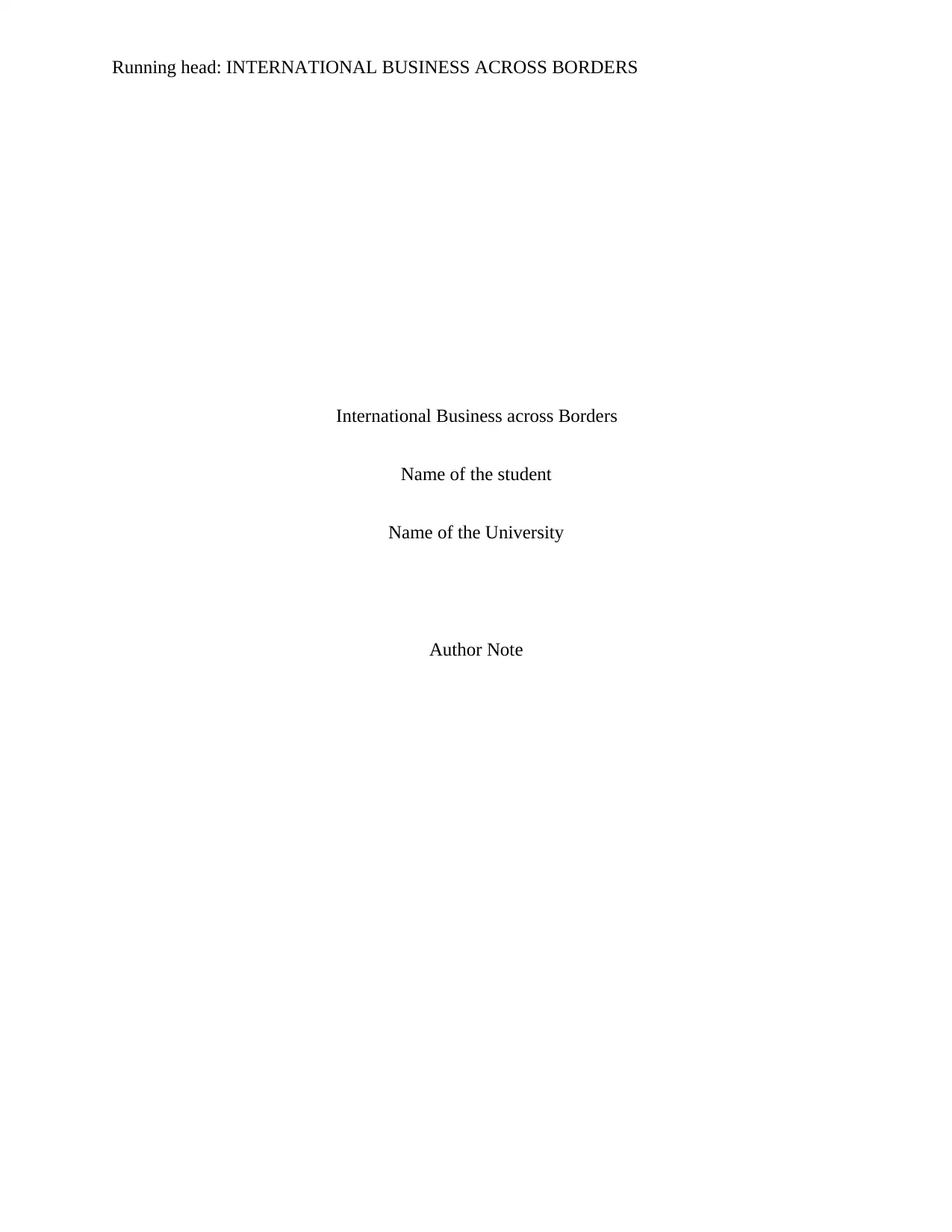
Running head: INTERNATIONAL BUSINESS ACROSS BORDERS
International Business across Borders
Name of the student
Name of the University
Author Note
International Business across Borders
Name of the student
Name of the University
Author Note
Paraphrase This Document
Need a fresh take? Get an instant paraphrase of this document with our AI Paraphraser
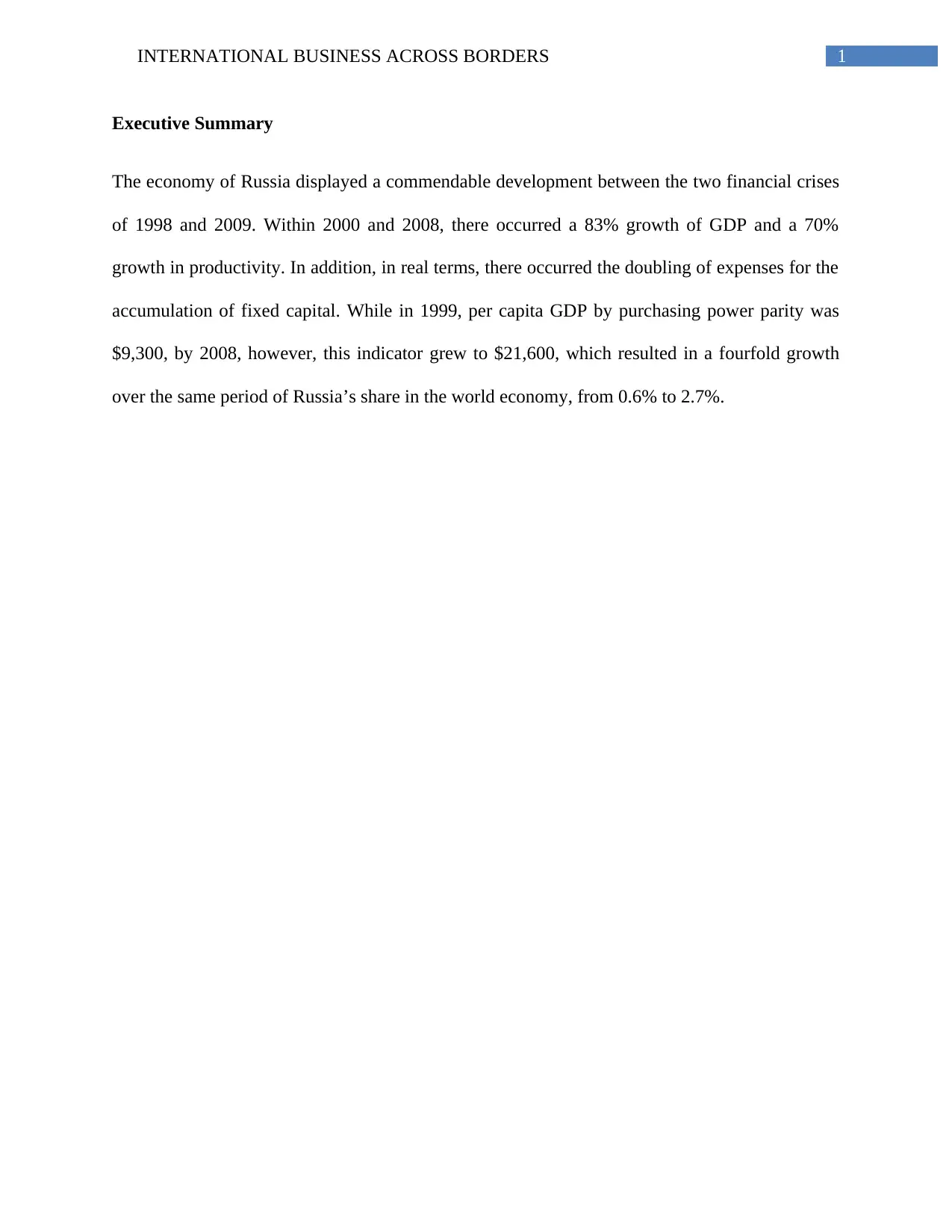
1INTERNATIONAL BUSINESS ACROSS BORDERS
Executive Summary
The economy of Russia displayed a commendable development between the two financial crises
of 1998 and 2009. Within 2000 and 2008, there occurred a 83% growth of GDP and a 70%
growth in productivity. In addition, in real terms, there occurred the doubling of expenses for the
accumulation of fixed capital. While in 1999, per capita GDP by purchasing power parity was
$9,300, by 2008, however, this indicator grew to $21,600, which resulted in a fourfold growth
over the same period of Russia’s share in the world economy, from 0.6% to 2.7%.
Executive Summary
The economy of Russia displayed a commendable development between the two financial crises
of 1998 and 2009. Within 2000 and 2008, there occurred a 83% growth of GDP and a 70%
growth in productivity. In addition, in real terms, there occurred the doubling of expenses for the
accumulation of fixed capital. While in 1999, per capita GDP by purchasing power parity was
$9,300, by 2008, however, this indicator grew to $21,600, which resulted in a fourfold growth
over the same period of Russia’s share in the world economy, from 0.6% to 2.7%.
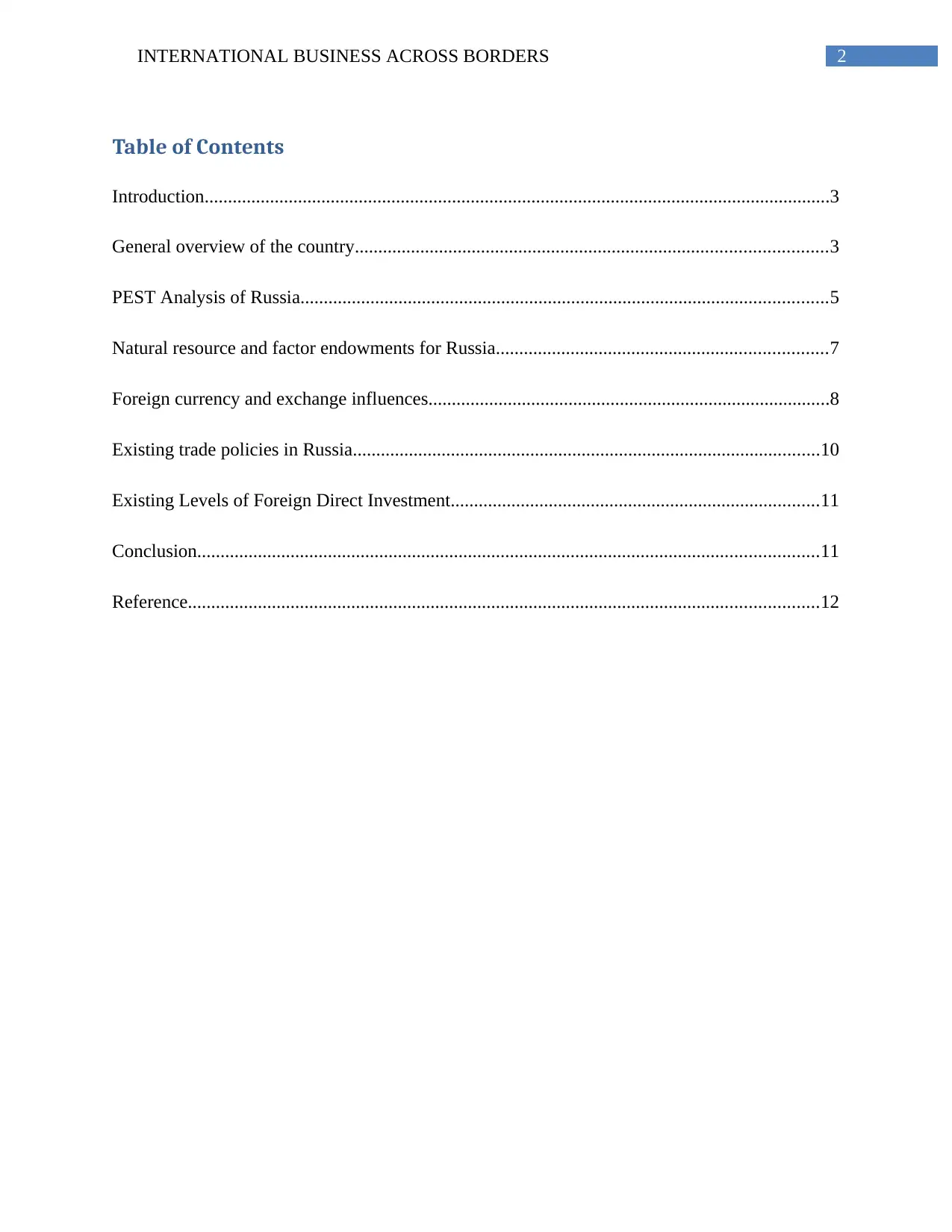
2INTERNATIONAL BUSINESS ACROSS BORDERS
Table of Contents
Introduction......................................................................................................................................3
General overview of the country.....................................................................................................3
PEST Analysis of Russia.................................................................................................................5
Natural resource and factor endowments for Russia.......................................................................7
Foreign currency and exchange influences......................................................................................8
Existing trade policies in Russia....................................................................................................10
Existing Levels of Foreign Direct Investment...............................................................................11
Conclusion.....................................................................................................................................11
Reference.......................................................................................................................................12
Table of Contents
Introduction......................................................................................................................................3
General overview of the country.....................................................................................................3
PEST Analysis of Russia.................................................................................................................5
Natural resource and factor endowments for Russia.......................................................................7
Foreign currency and exchange influences......................................................................................8
Existing trade policies in Russia....................................................................................................10
Existing Levels of Foreign Direct Investment...............................................................................11
Conclusion.....................................................................................................................................11
Reference.......................................................................................................................................12
⊘ This is a preview!⊘
Do you want full access?
Subscribe today to unlock all pages.

Trusted by 1+ million students worldwide
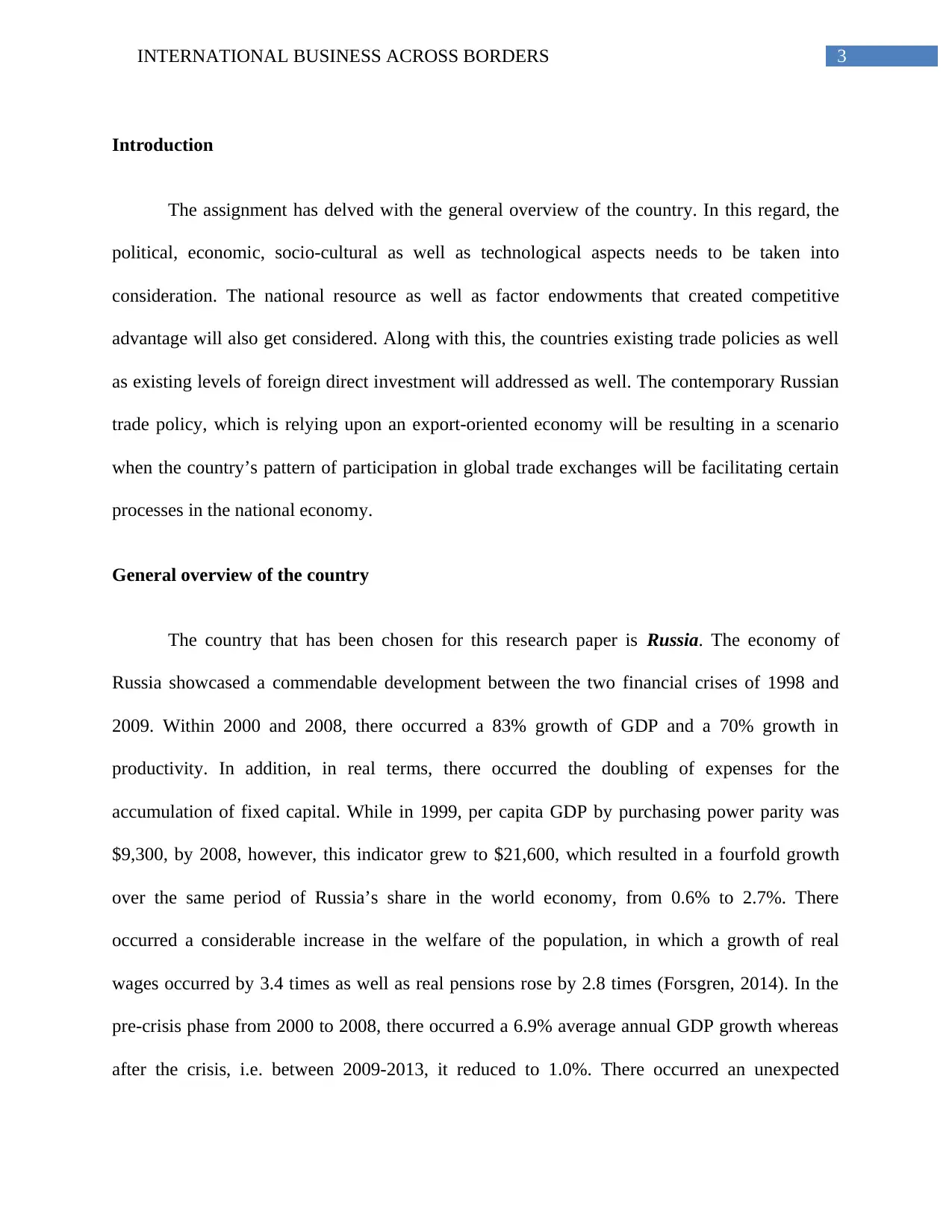
3INTERNATIONAL BUSINESS ACROSS BORDERS
Introduction
The assignment has delved with the general overview of the country. In this regard, the
political, economic, socio-cultural as well as technological aspects needs to be taken into
consideration. The national resource as well as factor endowments that created competitive
advantage will also get considered. Along with this, the countries existing trade policies as well
as existing levels of foreign direct investment will addressed as well. The contemporary Russian
trade policy, which is relying upon an export-oriented economy will be resulting in a scenario
when the country’s pattern of participation in global trade exchanges will be facilitating certain
processes in the national economy.
General overview of the country
The country that has been chosen for this research paper is Russia. The economy of
Russia showcased a commendable development between the two financial crises of 1998 and
2009. Within 2000 and 2008, there occurred a 83% growth of GDP and a 70% growth in
productivity. In addition, in real terms, there occurred the doubling of expenses for the
accumulation of fixed capital. While in 1999, per capita GDP by purchasing power parity was
$9,300, by 2008, however, this indicator grew to $21,600, which resulted in a fourfold growth
over the same period of Russia’s share in the world economy, from 0.6% to 2.7%. There
occurred a considerable increase in the welfare of the population, in which a growth of real
wages occurred by 3.4 times as well as real pensions rose by 2.8 times (Forsgren, 2014). In the
pre-crisis phase from 2000 to 2008, there occurred a 6.9% average annual GDP growth whereas
after the crisis, i.e. between 2009-2013, it reduced to 1.0%. There occurred an unexpected
Introduction
The assignment has delved with the general overview of the country. In this regard, the
political, economic, socio-cultural as well as technological aspects needs to be taken into
consideration. The national resource as well as factor endowments that created competitive
advantage will also get considered. Along with this, the countries existing trade policies as well
as existing levels of foreign direct investment will addressed as well. The contemporary Russian
trade policy, which is relying upon an export-oriented economy will be resulting in a scenario
when the country’s pattern of participation in global trade exchanges will be facilitating certain
processes in the national economy.
General overview of the country
The country that has been chosen for this research paper is Russia. The economy of
Russia showcased a commendable development between the two financial crises of 1998 and
2009. Within 2000 and 2008, there occurred a 83% growth of GDP and a 70% growth in
productivity. In addition, in real terms, there occurred the doubling of expenses for the
accumulation of fixed capital. While in 1999, per capita GDP by purchasing power parity was
$9,300, by 2008, however, this indicator grew to $21,600, which resulted in a fourfold growth
over the same period of Russia’s share in the world economy, from 0.6% to 2.7%. There
occurred a considerable increase in the welfare of the population, in which a growth of real
wages occurred by 3.4 times as well as real pensions rose by 2.8 times (Forsgren, 2014). In the
pre-crisis phase from 2000 to 2008, there occurred a 6.9% average annual GDP growth whereas
after the crisis, i.e. between 2009-2013, it reduced to 1.0%. There occurred an unexpected
Paraphrase This Document
Need a fresh take? Get an instant paraphrase of this document with our AI Paraphraser
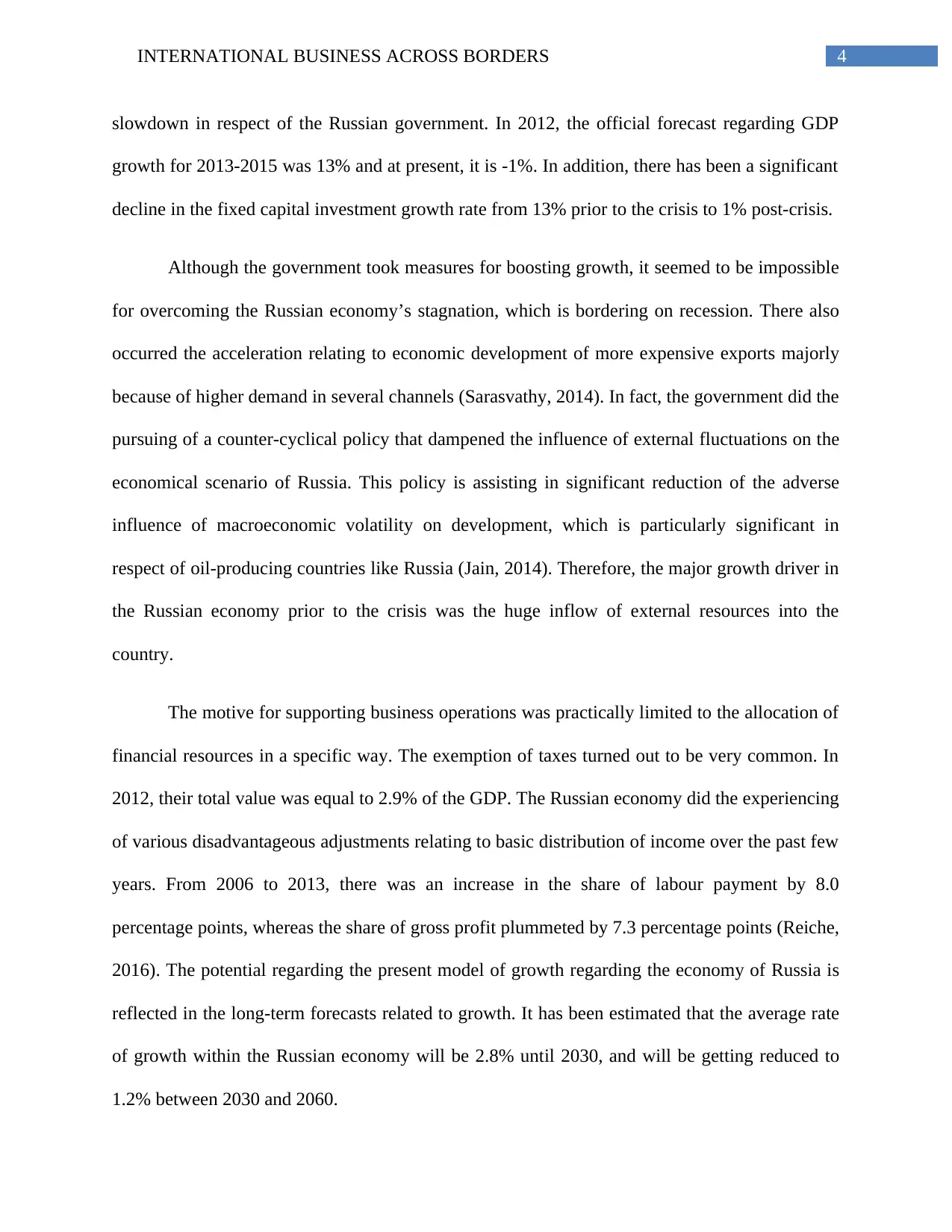
4INTERNATIONAL BUSINESS ACROSS BORDERS
slowdown in respect of the Russian government. In 2012, the official forecast regarding GDP
growth for 2013-2015 was 13% and at present, it is -1%. In addition, there has been a significant
decline in the fixed capital investment growth rate from 13% prior to the crisis to 1% post-crisis.
Although the government took measures for boosting growth, it seemed to be impossible
for overcoming the Russian economy’s stagnation, which is bordering on recession. There also
occurred the acceleration relating to economic development of more expensive exports majorly
because of higher demand in several channels (Sarasvathy, 2014). In fact, the government did the
pursuing of a counter-cyclical policy that dampened the influence of external fluctuations on the
economical scenario of Russia. This policy is assisting in significant reduction of the adverse
influence of macroeconomic volatility on development, which is particularly significant in
respect of oil-producing countries like Russia (Jain, 2014). Therefore, the major growth driver in
the Russian economy prior to the crisis was the huge inflow of external resources into the
country.
The motive for supporting business operations was practically limited to the allocation of
financial resources in a specific way. The exemption of taxes turned out to be very common. In
2012, their total value was equal to 2.9% of the GDP. The Russian economy did the experiencing
of various disadvantageous adjustments relating to basic distribution of income over the past few
years. From 2006 to 2013, there was an increase in the share of labour payment by 8.0
percentage points, whereas the share of gross profit plummeted by 7.3 percentage points (Reiche,
2016). The potential regarding the present model of growth regarding the economy of Russia is
reflected in the long-term forecasts related to growth. It has been estimated that the average rate
of growth within the Russian economy will be 2.8% until 2030, and will be getting reduced to
1.2% between 2030 and 2060.
slowdown in respect of the Russian government. In 2012, the official forecast regarding GDP
growth for 2013-2015 was 13% and at present, it is -1%. In addition, there has been a significant
decline in the fixed capital investment growth rate from 13% prior to the crisis to 1% post-crisis.
Although the government took measures for boosting growth, it seemed to be impossible
for overcoming the Russian economy’s stagnation, which is bordering on recession. There also
occurred the acceleration relating to economic development of more expensive exports majorly
because of higher demand in several channels (Sarasvathy, 2014). In fact, the government did the
pursuing of a counter-cyclical policy that dampened the influence of external fluctuations on the
economical scenario of Russia. This policy is assisting in significant reduction of the adverse
influence of macroeconomic volatility on development, which is particularly significant in
respect of oil-producing countries like Russia (Jain, 2014). Therefore, the major growth driver in
the Russian economy prior to the crisis was the huge inflow of external resources into the
country.
The motive for supporting business operations was practically limited to the allocation of
financial resources in a specific way. The exemption of taxes turned out to be very common. In
2012, their total value was equal to 2.9% of the GDP. The Russian economy did the experiencing
of various disadvantageous adjustments relating to basic distribution of income over the past few
years. From 2006 to 2013, there was an increase in the share of labour payment by 8.0
percentage points, whereas the share of gross profit plummeted by 7.3 percentage points (Reiche,
2016). The potential regarding the present model of growth regarding the economy of Russia is
reflected in the long-term forecasts related to growth. It has been estimated that the average rate
of growth within the Russian economy will be 2.8% until 2030, and will be getting reduced to
1.2% between 2030 and 2060.
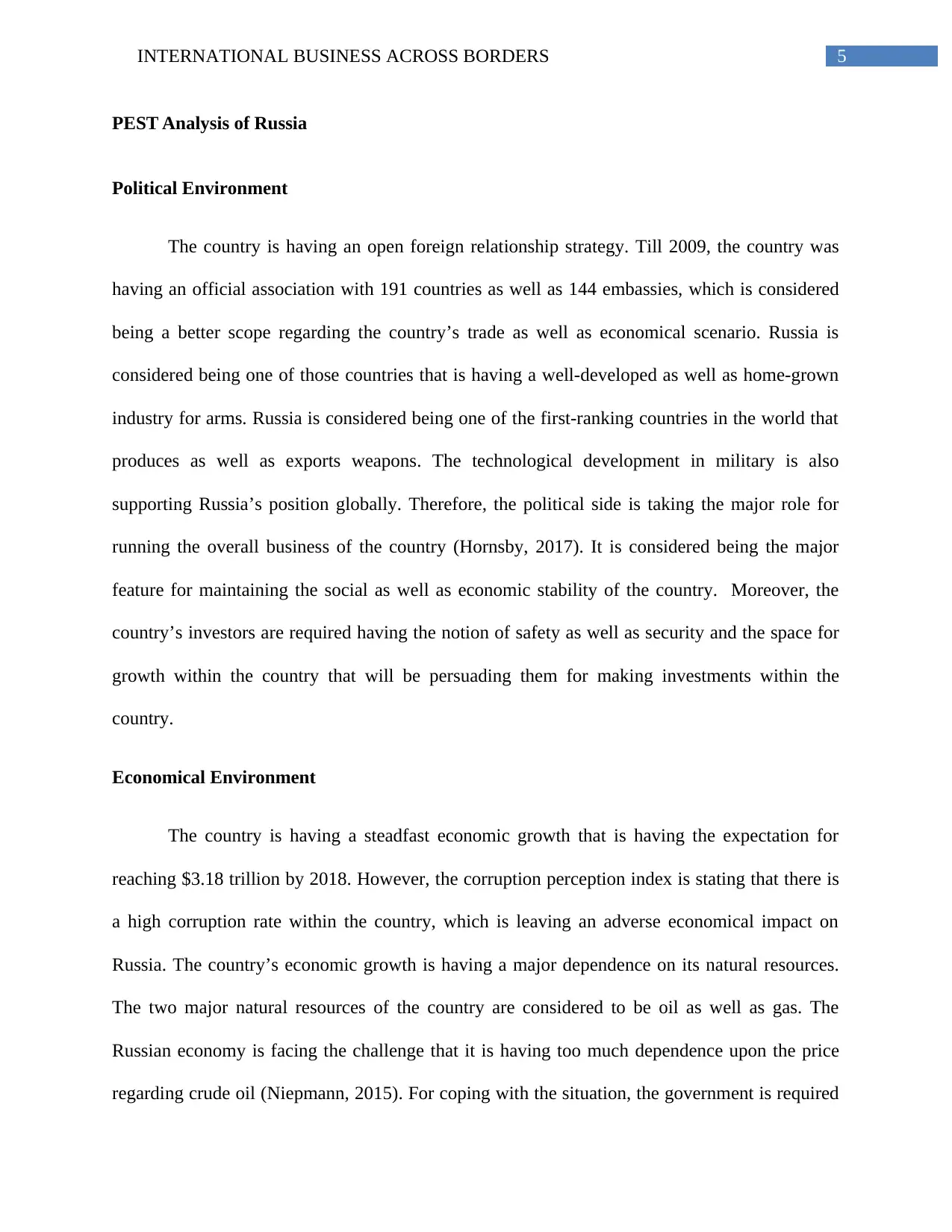
5INTERNATIONAL BUSINESS ACROSS BORDERS
PEST Analysis of Russia
Political Environment
The country is having an open foreign relationship strategy. Till 2009, the country was
having an official association with 191 countries as well as 144 embassies, which is considered
being a better scope regarding the country’s trade as well as economical scenario. Russia is
considered being one of those countries that is having a well-developed as well as home-grown
industry for arms. Russia is considered being one of the first-ranking countries in the world that
produces as well as exports weapons. The technological development in military is also
supporting Russia’s position globally. Therefore, the political side is taking the major role for
running the overall business of the country (Hornsby, 2017). It is considered being the major
feature for maintaining the social as well as economic stability of the country. Moreover, the
country’s investors are required having the notion of safety as well as security and the space for
growth within the country that will be persuading them for making investments within the
country.
Economical Environment
The country is having a steadfast economic growth that is having the expectation for
reaching $3.18 trillion by 2018. However, the corruption perception index is stating that there is
a high corruption rate within the country, which is leaving an adverse economical impact on
Russia. The country’s economic growth is having a major dependence on its natural resources.
The two major natural resources of the country are considered to be oil as well as gas. The
Russian economy is facing the challenge that it is having too much dependence upon the price
regarding crude oil (Niepmann, 2015). For coping with the situation, the government is required
PEST Analysis of Russia
Political Environment
The country is having an open foreign relationship strategy. Till 2009, the country was
having an official association with 191 countries as well as 144 embassies, which is considered
being a better scope regarding the country’s trade as well as economical scenario. Russia is
considered being one of those countries that is having a well-developed as well as home-grown
industry for arms. Russia is considered being one of the first-ranking countries in the world that
produces as well as exports weapons. The technological development in military is also
supporting Russia’s position globally. Therefore, the political side is taking the major role for
running the overall business of the country (Hornsby, 2017). It is considered being the major
feature for maintaining the social as well as economic stability of the country. Moreover, the
country’s investors are required having the notion of safety as well as security and the space for
growth within the country that will be persuading them for making investments within the
country.
Economical Environment
The country is having a steadfast economic growth that is having the expectation for
reaching $3.18 trillion by 2018. However, the corruption perception index is stating that there is
a high corruption rate within the country, which is leaving an adverse economical impact on
Russia. The country’s economic growth is having a major dependence on its natural resources.
The two major natural resources of the country are considered to be oil as well as gas. The
Russian economy is facing the challenge that it is having too much dependence upon the price
regarding crude oil (Niepmann, 2015). For coping with the situation, the government is required
⊘ This is a preview!⊘
Do you want full access?
Subscribe today to unlock all pages.

Trusted by 1+ million students worldwide
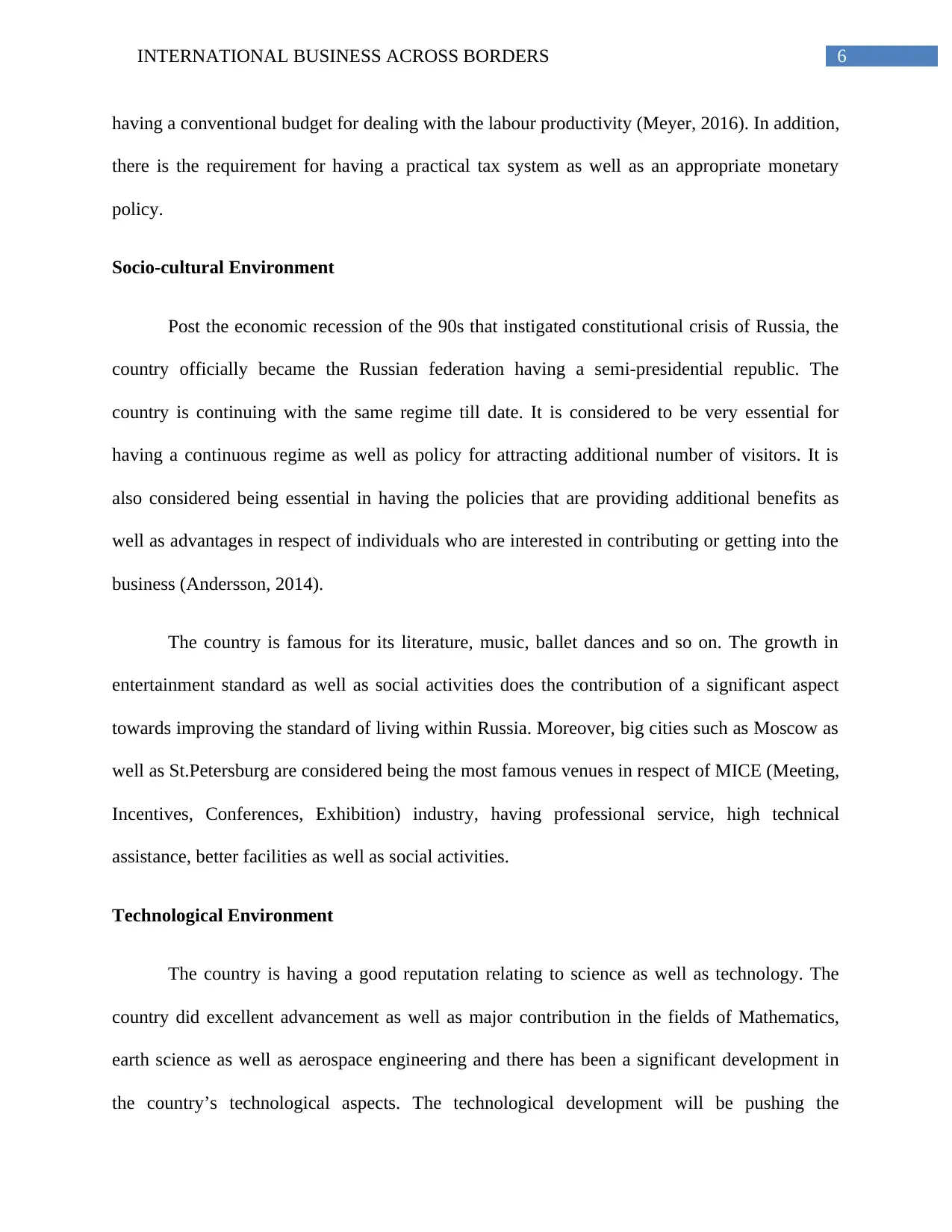
6INTERNATIONAL BUSINESS ACROSS BORDERS
having a conventional budget for dealing with the labour productivity (Meyer, 2016). In addition,
there is the requirement for having a practical tax system as well as an appropriate monetary
policy.
Socio-cultural Environment
Post the economic recession of the 90s that instigated constitutional crisis of Russia, the
country officially became the Russian federation having a semi-presidential republic. The
country is continuing with the same regime till date. It is considered to be very essential for
having a continuous regime as well as policy for attracting additional number of visitors. It is
also considered being essential in having the policies that are providing additional benefits as
well as advantages in respect of individuals who are interested in contributing or getting into the
business (Andersson, 2014).
The country is famous for its literature, music, ballet dances and so on. The growth in
entertainment standard as well as social activities does the contribution of a significant aspect
towards improving the standard of living within Russia. Moreover, big cities such as Moscow as
well as St.Petersburg are considered being the most famous venues in respect of MICE (Meeting,
Incentives, Conferences, Exhibition) industry, having professional service, high technical
assistance, better facilities as well as social activities.
Technological Environment
The country is having a good reputation relating to science as well as technology. The
country did excellent advancement as well as major contribution in the fields of Mathematics,
earth science as well as aerospace engineering and there has been a significant development in
the country’s technological aspects. The technological development will be pushing the
having a conventional budget for dealing with the labour productivity (Meyer, 2016). In addition,
there is the requirement for having a practical tax system as well as an appropriate monetary
policy.
Socio-cultural Environment
Post the economic recession of the 90s that instigated constitutional crisis of Russia, the
country officially became the Russian federation having a semi-presidential republic. The
country is continuing with the same regime till date. It is considered to be very essential for
having a continuous regime as well as policy for attracting additional number of visitors. It is
also considered being essential in having the policies that are providing additional benefits as
well as advantages in respect of individuals who are interested in contributing or getting into the
business (Andersson, 2014).
The country is famous for its literature, music, ballet dances and so on. The growth in
entertainment standard as well as social activities does the contribution of a significant aspect
towards improving the standard of living within Russia. Moreover, big cities such as Moscow as
well as St.Petersburg are considered being the most famous venues in respect of MICE (Meeting,
Incentives, Conferences, Exhibition) industry, having professional service, high technical
assistance, better facilities as well as social activities.
Technological Environment
The country is having a good reputation relating to science as well as technology. The
country did excellent advancement as well as major contribution in the fields of Mathematics,
earth science as well as aerospace engineering and there has been a significant development in
the country’s technological aspects. The technological development will be pushing the
Paraphrase This Document
Need a fresh take? Get an instant paraphrase of this document with our AI Paraphraser
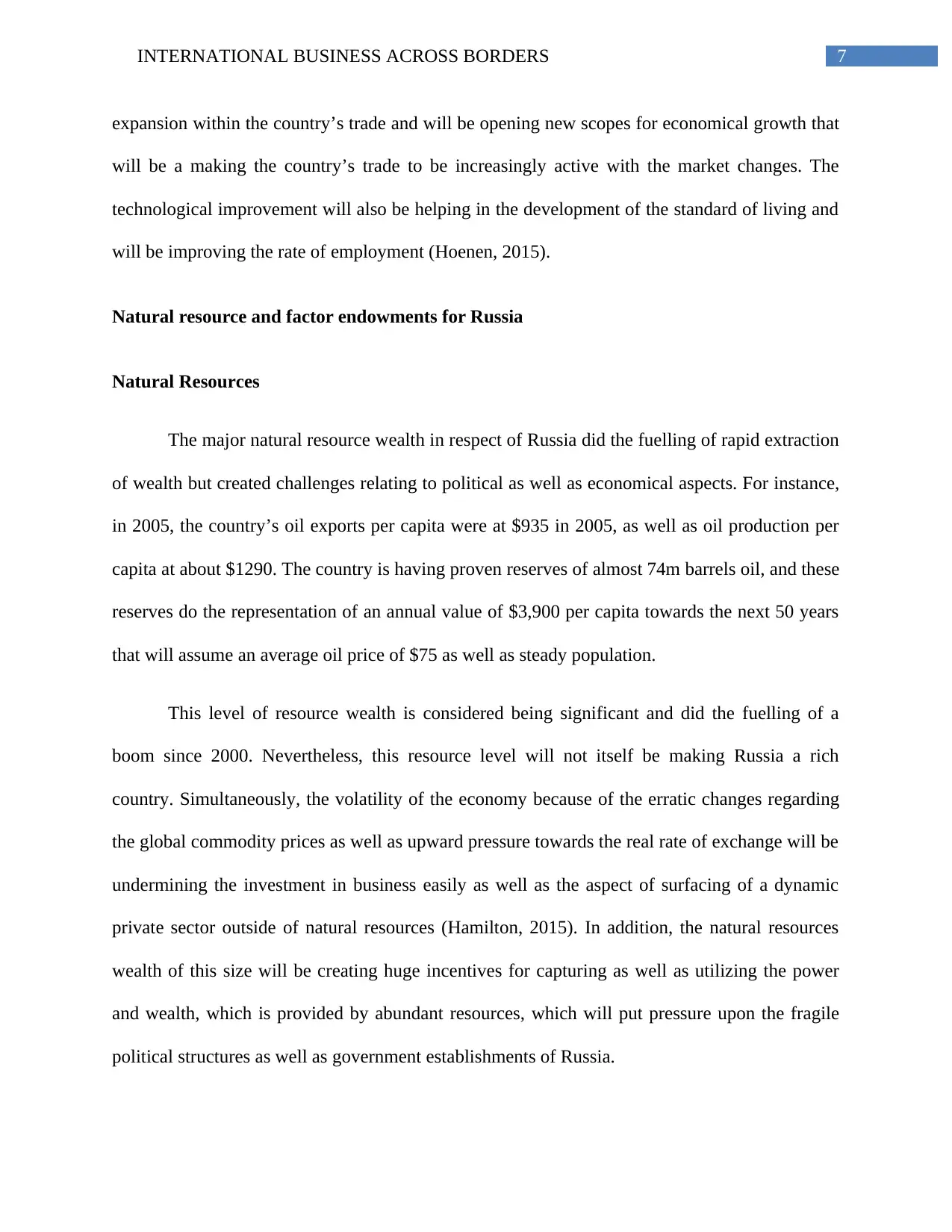
7INTERNATIONAL BUSINESS ACROSS BORDERS
expansion within the country’s trade and will be opening new scopes for economical growth that
will be a making the country’s trade to be increasingly active with the market changes. The
technological improvement will also be helping in the development of the standard of living and
will be improving the rate of employment (Hoenen, 2015).
Natural resource and factor endowments for Russia
Natural Resources
The major natural resource wealth in respect of Russia did the fuelling of rapid extraction
of wealth but created challenges relating to political as well as economical aspects. For instance,
in 2005, the country’s oil exports per capita were at $935 in 2005, as well as oil production per
capita at about $1290. The country is having proven reserves of almost 74m barrels oil, and these
reserves do the representation of an annual value of $3,900 per capita towards the next 50 years
that will assume an average oil price of $75 as well as steady population.
This level of resource wealth is considered being significant and did the fuelling of a
boom since 2000. Nevertheless, this resource level will not itself be making Russia a rich
country. Simultaneously, the volatility of the economy because of the erratic changes regarding
the global commodity prices as well as upward pressure towards the real rate of exchange will be
undermining the investment in business easily as well as the aspect of surfacing of a dynamic
private sector outside of natural resources (Hamilton, 2015). In addition, the natural resources
wealth of this size will be creating huge incentives for capturing as well as utilizing the power
and wealth, which is provided by abundant resources, which will put pressure upon the fragile
political structures as well as government establishments of Russia.
expansion within the country’s trade and will be opening new scopes for economical growth that
will be a making the country’s trade to be increasingly active with the market changes. The
technological improvement will also be helping in the development of the standard of living and
will be improving the rate of employment (Hoenen, 2015).
Natural resource and factor endowments for Russia
Natural Resources
The major natural resource wealth in respect of Russia did the fuelling of rapid extraction
of wealth but created challenges relating to political as well as economical aspects. For instance,
in 2005, the country’s oil exports per capita were at $935 in 2005, as well as oil production per
capita at about $1290. The country is having proven reserves of almost 74m barrels oil, and these
reserves do the representation of an annual value of $3,900 per capita towards the next 50 years
that will assume an average oil price of $75 as well as steady population.
This level of resource wealth is considered being significant and did the fuelling of a
boom since 2000. Nevertheless, this resource level will not itself be making Russia a rich
country. Simultaneously, the volatility of the economy because of the erratic changes regarding
the global commodity prices as well as upward pressure towards the real rate of exchange will be
undermining the investment in business easily as well as the aspect of surfacing of a dynamic
private sector outside of natural resources (Hamilton, 2015). In addition, the natural resources
wealth of this size will be creating huge incentives for capturing as well as utilizing the power
and wealth, which is provided by abundant resources, which will put pressure upon the fragile
political structures as well as government establishments of Russia.
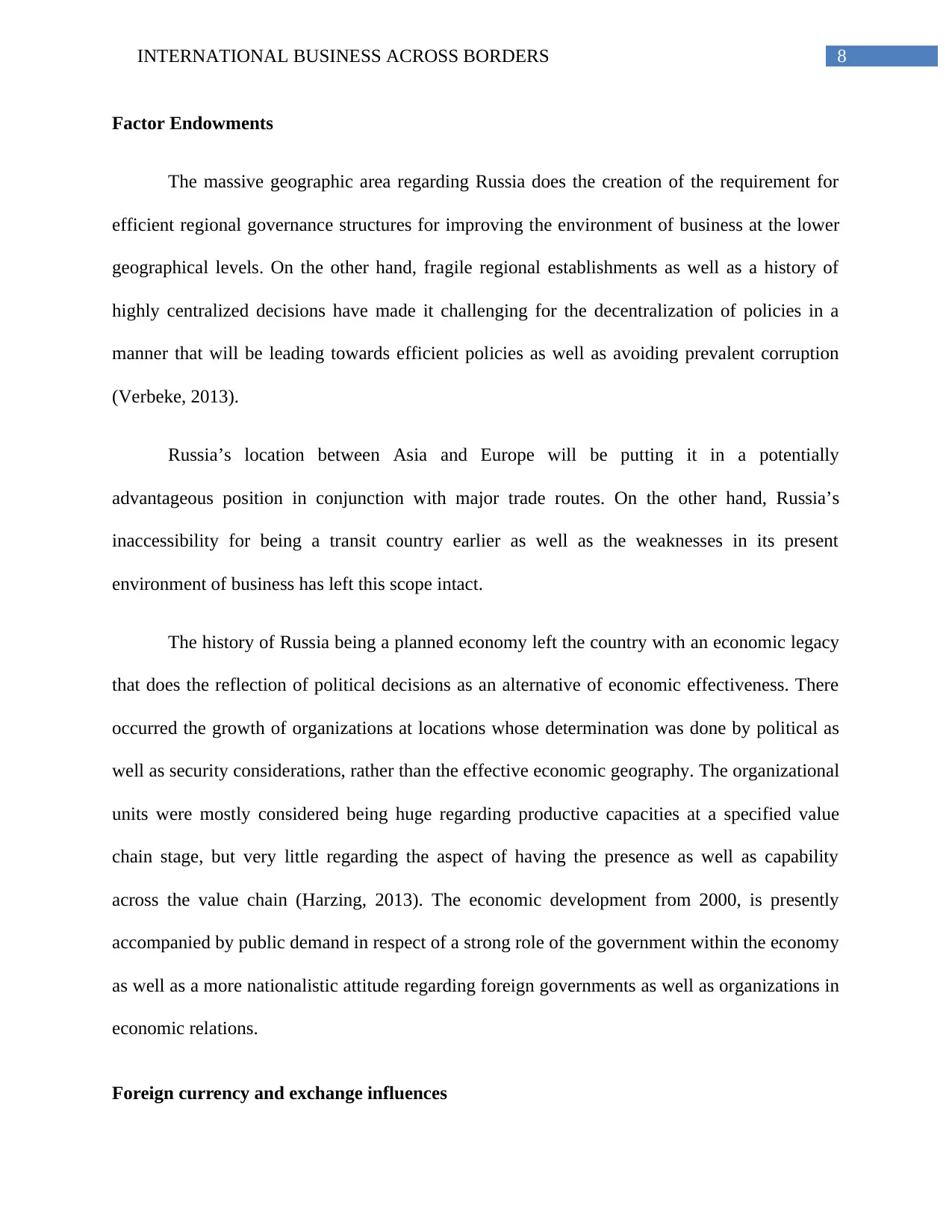
8INTERNATIONAL BUSINESS ACROSS BORDERS
Factor Endowments
The massive geographic area regarding Russia does the creation of the requirement for
efficient regional governance structures for improving the environment of business at the lower
geographical levels. On the other hand, fragile regional establishments as well as a history of
highly centralized decisions have made it challenging for the decentralization of policies in a
manner that will be leading towards efficient policies as well as avoiding prevalent corruption
(Verbeke, 2013).
Russia’s location between Asia and Europe will be putting it in a potentially
advantageous position in conjunction with major trade routes. On the other hand, Russia’s
inaccessibility for being a transit country earlier as well as the weaknesses in its present
environment of business has left this scope intact.
The history of Russia being a planned economy left the country with an economic legacy
that does the reflection of political decisions as an alternative of economic effectiveness. There
occurred the growth of organizations at locations whose determination was done by political as
well as security considerations, rather than the effective economic geography. The organizational
units were mostly considered being huge regarding productive capacities at a specified value
chain stage, but very little regarding the aspect of having the presence as well as capability
across the value chain (Harzing, 2013). The economic development from 2000, is presently
accompanied by public demand in respect of a strong role of the government within the economy
as well as a more nationalistic attitude regarding foreign governments as well as organizations in
economic relations.
Foreign currency and exchange influences
Factor Endowments
The massive geographic area regarding Russia does the creation of the requirement for
efficient regional governance structures for improving the environment of business at the lower
geographical levels. On the other hand, fragile regional establishments as well as a history of
highly centralized decisions have made it challenging for the decentralization of policies in a
manner that will be leading towards efficient policies as well as avoiding prevalent corruption
(Verbeke, 2013).
Russia’s location between Asia and Europe will be putting it in a potentially
advantageous position in conjunction with major trade routes. On the other hand, Russia’s
inaccessibility for being a transit country earlier as well as the weaknesses in its present
environment of business has left this scope intact.
The history of Russia being a planned economy left the country with an economic legacy
that does the reflection of political decisions as an alternative of economic effectiveness. There
occurred the growth of organizations at locations whose determination was done by political as
well as security considerations, rather than the effective economic geography. The organizational
units were mostly considered being huge regarding productive capacities at a specified value
chain stage, but very little regarding the aspect of having the presence as well as capability
across the value chain (Harzing, 2013). The economic development from 2000, is presently
accompanied by public demand in respect of a strong role of the government within the economy
as well as a more nationalistic attitude regarding foreign governments as well as organizations in
economic relations.
Foreign currency and exchange influences
⊘ This is a preview!⊘
Do you want full access?
Subscribe today to unlock all pages.

Trusted by 1+ million students worldwide
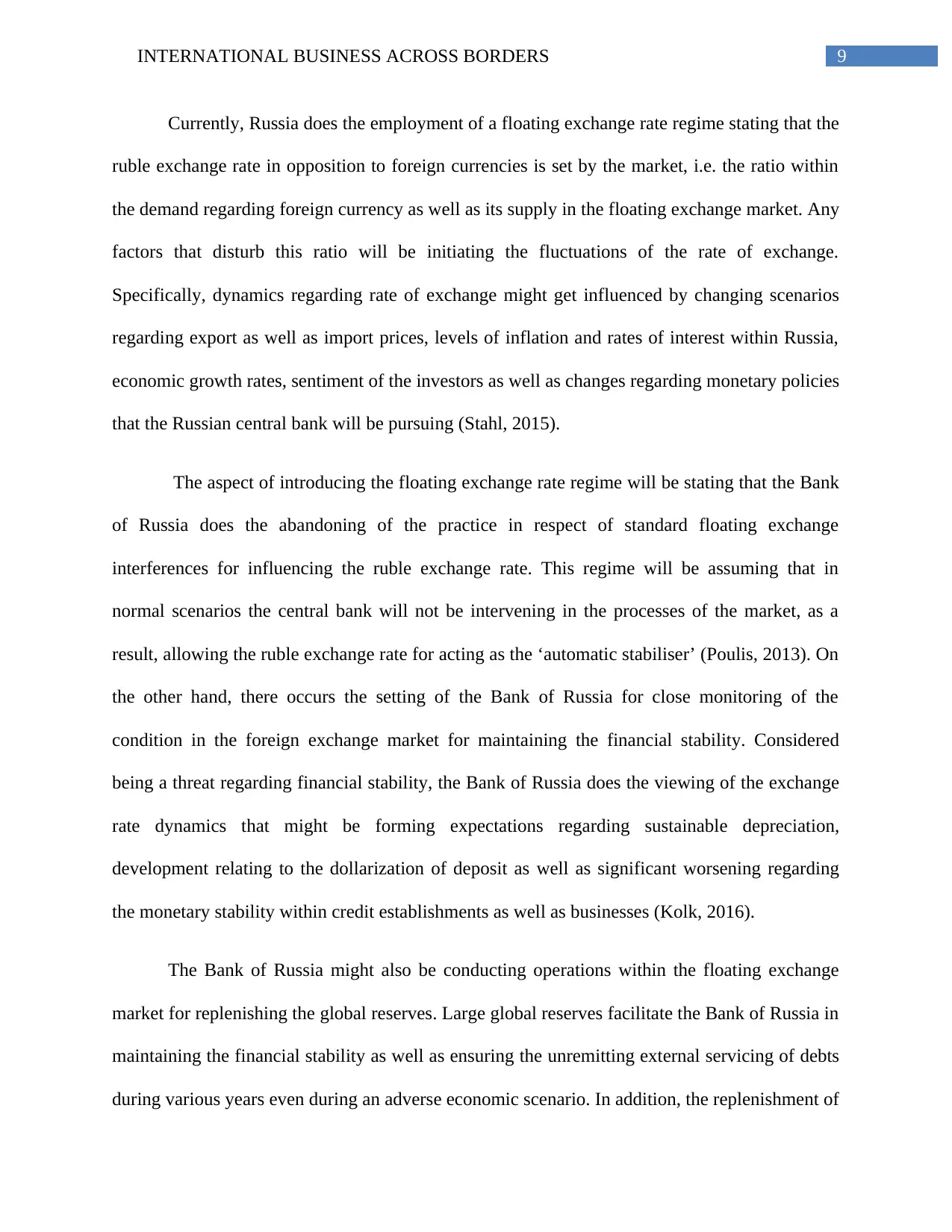
9INTERNATIONAL BUSINESS ACROSS BORDERS
Currently, Russia does the employment of a floating exchange rate regime stating that the
ruble exchange rate in opposition to foreign currencies is set by the market, i.e. the ratio within
the demand regarding foreign currency as well as its supply in the floating exchange market. Any
factors that disturb this ratio will be initiating the fluctuations of the rate of exchange.
Specifically, dynamics regarding rate of exchange might get influenced by changing scenarios
regarding export as well as import prices, levels of inflation and rates of interest within Russia,
economic growth rates, sentiment of the investors as well as changes regarding monetary policies
that the Russian central bank will be pursuing (Stahl, 2015).
The aspect of introducing the floating exchange rate regime will be stating that the Bank
of Russia does the abandoning of the practice in respect of standard floating exchange
interferences for influencing the ruble exchange rate. This regime will be assuming that in
normal scenarios the central bank will not be intervening in the processes of the market, as a
result, allowing the ruble exchange rate for acting as the ‘automatic stabiliser’ (Poulis, 2013). On
the other hand, there occurs the setting of the Bank of Russia for close monitoring of the
condition in the foreign exchange market for maintaining the financial stability. Considered
being a threat regarding financial stability, the Bank of Russia does the viewing of the exchange
rate dynamics that might be forming expectations regarding sustainable depreciation,
development relating to the dollarization of deposit as well as significant worsening regarding
the monetary stability within credit establishments as well as businesses (Kolk, 2016).
The Bank of Russia might also be conducting operations within the floating exchange
market for replenishing the global reserves. Large global reserves facilitate the Bank of Russia in
maintaining the financial stability as well as ensuring the unremitting external servicing of debts
during various years even during an adverse economic scenario. In addition, the replenishment of
Currently, Russia does the employment of a floating exchange rate regime stating that the
ruble exchange rate in opposition to foreign currencies is set by the market, i.e. the ratio within
the demand regarding foreign currency as well as its supply in the floating exchange market. Any
factors that disturb this ratio will be initiating the fluctuations of the rate of exchange.
Specifically, dynamics regarding rate of exchange might get influenced by changing scenarios
regarding export as well as import prices, levels of inflation and rates of interest within Russia,
economic growth rates, sentiment of the investors as well as changes regarding monetary policies
that the Russian central bank will be pursuing (Stahl, 2015).
The aspect of introducing the floating exchange rate regime will be stating that the Bank
of Russia does the abandoning of the practice in respect of standard floating exchange
interferences for influencing the ruble exchange rate. This regime will be assuming that in
normal scenarios the central bank will not be intervening in the processes of the market, as a
result, allowing the ruble exchange rate for acting as the ‘automatic stabiliser’ (Poulis, 2013). On
the other hand, there occurs the setting of the Bank of Russia for close monitoring of the
condition in the foreign exchange market for maintaining the financial stability. Considered
being a threat regarding financial stability, the Bank of Russia does the viewing of the exchange
rate dynamics that might be forming expectations regarding sustainable depreciation,
development relating to the dollarization of deposit as well as significant worsening regarding
the monetary stability within credit establishments as well as businesses (Kolk, 2016).
The Bank of Russia might also be conducting operations within the floating exchange
market for replenishing the global reserves. Large global reserves facilitate the Bank of Russia in
maintaining the financial stability as well as ensuring the unremitting external servicing of debts
during various years even during an adverse economic scenario. In addition, the replenishment of
Paraphrase This Document
Need a fresh take? Get an instant paraphrase of this document with our AI Paraphraser
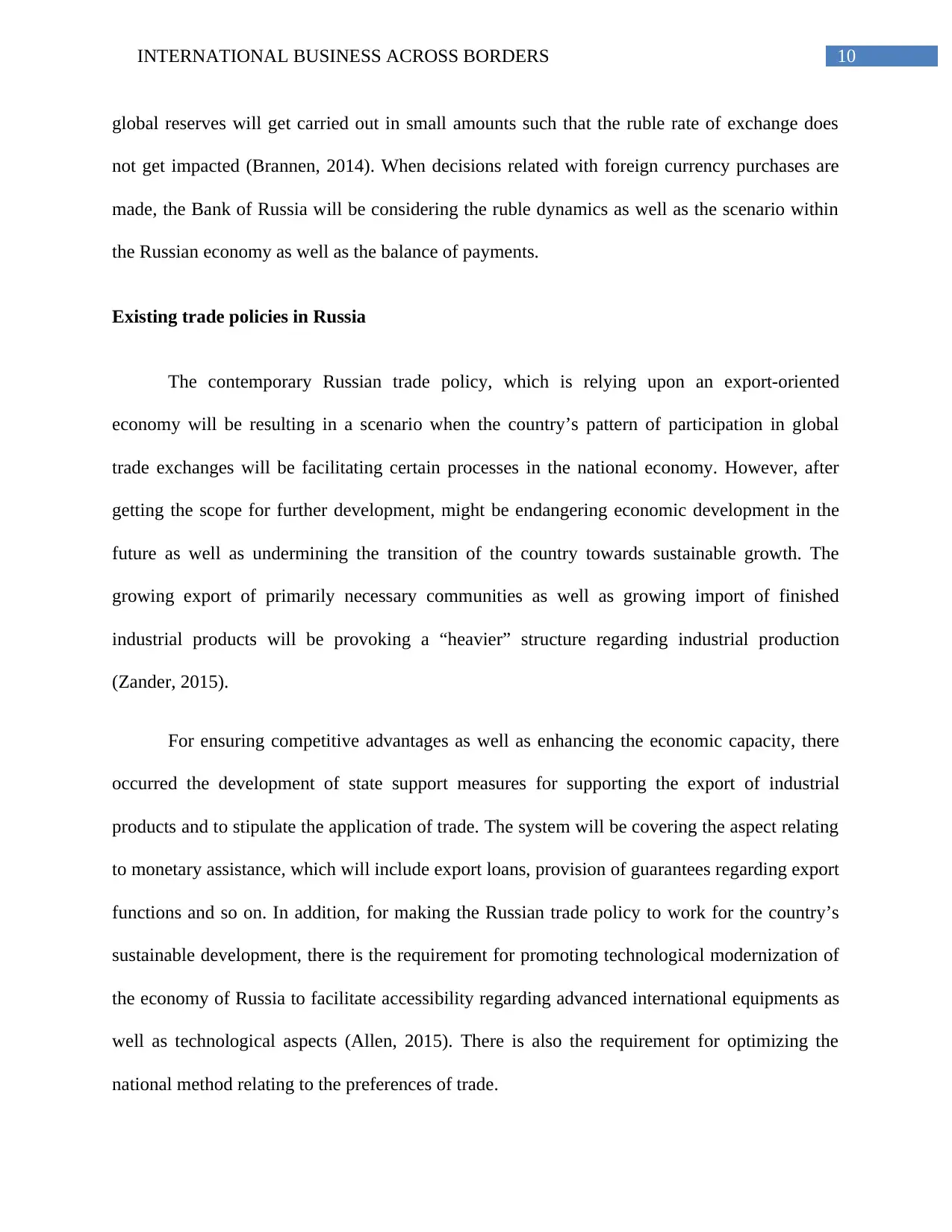
10INTERNATIONAL BUSINESS ACROSS BORDERS
global reserves will get carried out in small amounts such that the ruble rate of exchange does
not get impacted (Brannen, 2014). When decisions related with foreign currency purchases are
made, the Bank of Russia will be considering the ruble dynamics as well as the scenario within
the Russian economy as well as the balance of payments.
Existing trade policies in Russia
The contemporary Russian trade policy, which is relying upon an export-oriented
economy will be resulting in a scenario when the country’s pattern of participation in global
trade exchanges will be facilitating certain processes in the national economy. However, after
getting the scope for further development, might be endangering economic development in the
future as well as undermining the transition of the country towards sustainable growth. The
growing export of primarily necessary communities as well as growing import of finished
industrial products will be provoking a “heavier” structure regarding industrial production
(Zander, 2015).
For ensuring competitive advantages as well as enhancing the economic capacity, there
occurred the development of state support measures for supporting the export of industrial
products and to stipulate the application of trade. The system will be covering the aspect relating
to monetary assistance, which will include export loans, provision of guarantees regarding export
functions and so on. In addition, for making the Russian trade policy to work for the country’s
sustainable development, there is the requirement for promoting technological modernization of
the economy of Russia to facilitate accessibility regarding advanced international equipments as
well as technological aspects (Allen, 2015). There is also the requirement for optimizing the
national method relating to the preferences of trade.
global reserves will get carried out in small amounts such that the ruble rate of exchange does
not get impacted (Brannen, 2014). When decisions related with foreign currency purchases are
made, the Bank of Russia will be considering the ruble dynamics as well as the scenario within
the Russian economy as well as the balance of payments.
Existing trade policies in Russia
The contemporary Russian trade policy, which is relying upon an export-oriented
economy will be resulting in a scenario when the country’s pattern of participation in global
trade exchanges will be facilitating certain processes in the national economy. However, after
getting the scope for further development, might be endangering economic development in the
future as well as undermining the transition of the country towards sustainable growth. The
growing export of primarily necessary communities as well as growing import of finished
industrial products will be provoking a “heavier” structure regarding industrial production
(Zander, 2015).
For ensuring competitive advantages as well as enhancing the economic capacity, there
occurred the development of state support measures for supporting the export of industrial
products and to stipulate the application of trade. The system will be covering the aspect relating
to monetary assistance, which will include export loans, provision of guarantees regarding export
functions and so on. In addition, for making the Russian trade policy to work for the country’s
sustainable development, there is the requirement for promoting technological modernization of
the economy of Russia to facilitate accessibility regarding advanced international equipments as
well as technological aspects (Allen, 2015). There is also the requirement for optimizing the
national method relating to the preferences of trade.
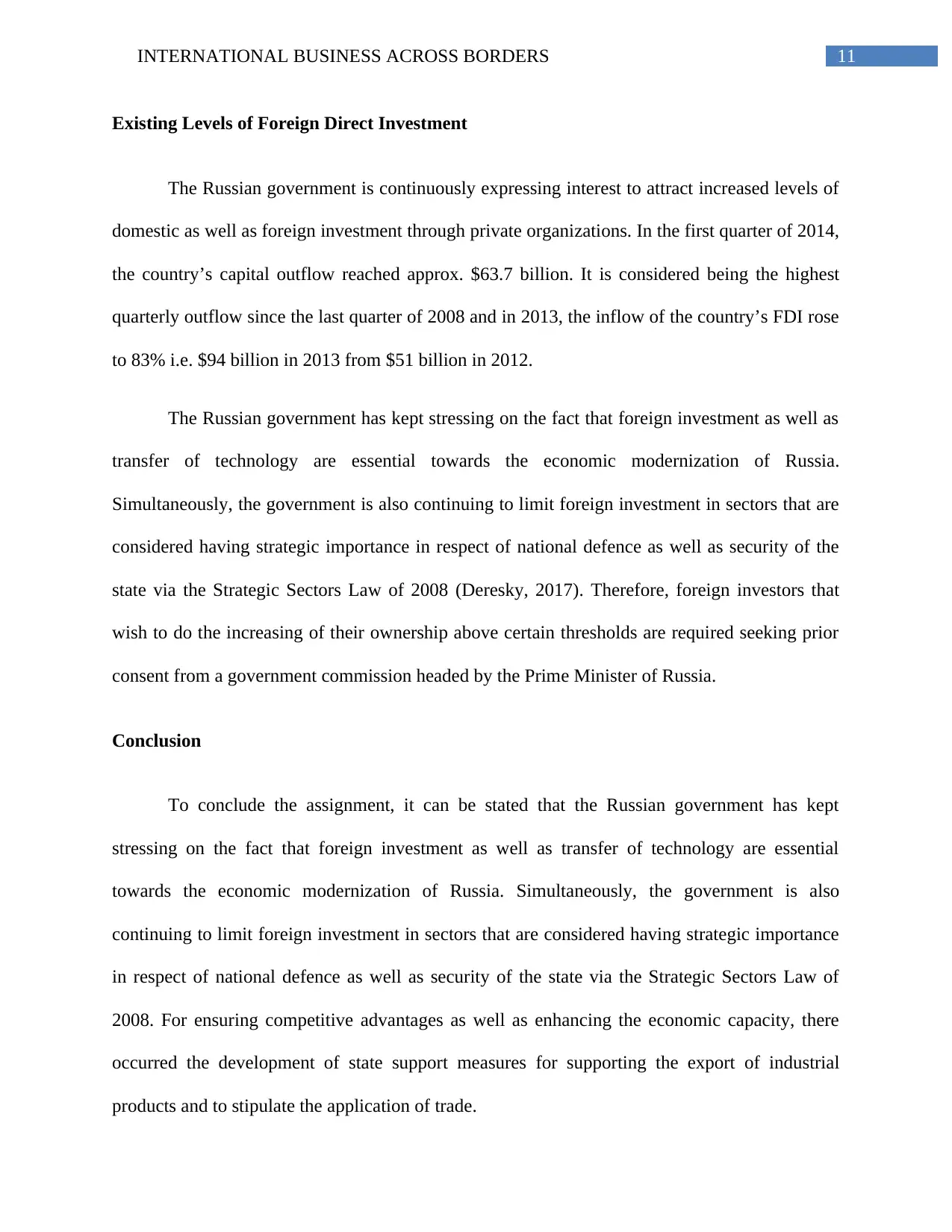
11INTERNATIONAL BUSINESS ACROSS BORDERS
Existing Levels of Foreign Direct Investment
The Russian government is continuously expressing interest to attract increased levels of
domestic as well as foreign investment through private organizations. In the first quarter of 2014,
the country’s capital outflow reached approx. $63.7 billion. It is considered being the highest
quarterly outflow since the last quarter of 2008 and in 2013, the inflow of the country’s FDI rose
to 83% i.e. $94 billion in 2013 from $51 billion in 2012.
The Russian government has kept stressing on the fact that foreign investment as well as
transfer of technology are essential towards the economic modernization of Russia.
Simultaneously, the government is also continuing to limit foreign investment in sectors that are
considered having strategic importance in respect of national defence as well as security of the
state via the Strategic Sectors Law of 2008 (Deresky, 2017). Therefore, foreign investors that
wish to do the increasing of their ownership above certain thresholds are required seeking prior
consent from a government commission headed by the Prime Minister of Russia.
Conclusion
To conclude the assignment, it can be stated that the Russian government has kept
stressing on the fact that foreign investment as well as transfer of technology are essential
towards the economic modernization of Russia. Simultaneously, the government is also
continuing to limit foreign investment in sectors that are considered having strategic importance
in respect of national defence as well as security of the state via the Strategic Sectors Law of
2008. For ensuring competitive advantages as well as enhancing the economic capacity, there
occurred the development of state support measures for supporting the export of industrial
products and to stipulate the application of trade.
Existing Levels of Foreign Direct Investment
The Russian government is continuously expressing interest to attract increased levels of
domestic as well as foreign investment through private organizations. In the first quarter of 2014,
the country’s capital outflow reached approx. $63.7 billion. It is considered being the highest
quarterly outflow since the last quarter of 2008 and in 2013, the inflow of the country’s FDI rose
to 83% i.e. $94 billion in 2013 from $51 billion in 2012.
The Russian government has kept stressing on the fact that foreign investment as well as
transfer of technology are essential towards the economic modernization of Russia.
Simultaneously, the government is also continuing to limit foreign investment in sectors that are
considered having strategic importance in respect of national defence as well as security of the
state via the Strategic Sectors Law of 2008 (Deresky, 2017). Therefore, foreign investors that
wish to do the increasing of their ownership above certain thresholds are required seeking prior
consent from a government commission headed by the Prime Minister of Russia.
Conclusion
To conclude the assignment, it can be stated that the Russian government has kept
stressing on the fact that foreign investment as well as transfer of technology are essential
towards the economic modernization of Russia. Simultaneously, the government is also
continuing to limit foreign investment in sectors that are considered having strategic importance
in respect of national defence as well as security of the state via the Strategic Sectors Law of
2008. For ensuring competitive advantages as well as enhancing the economic capacity, there
occurred the development of state support measures for supporting the export of industrial
products and to stipulate the application of trade.
⊘ This is a preview!⊘
Do you want full access?
Subscribe today to unlock all pages.

Trusted by 1+ million students worldwide
1 out of 15
Your All-in-One AI-Powered Toolkit for Academic Success.
+13062052269
info@desklib.com
Available 24*7 on WhatsApp / Email
![[object Object]](/_next/static/media/star-bottom.7253800d.svg)
Unlock your academic potential
Copyright © 2020–2025 A2Z Services. All Rights Reserved. Developed and managed by ZUCOL.

